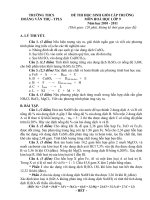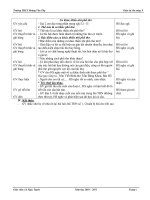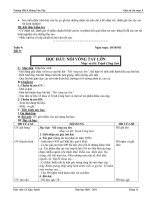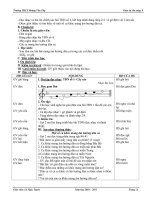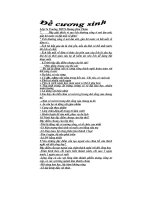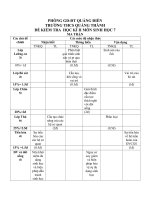trường thcs hoàng xuân hãn
Bạn đang xem bản rút gọn của tài liệu. Xem và tải ngay bản đầy đủ của tài liệu tại đây (189.21 KB, 8 trang )
<span class='text_page_counter'>(1)</span><div class='page_container' data-page=1>
February 22, 2011
Problems (with Solutions)
1 A set of identical square tiles with side length 1 is placed on a (very large) floor. Every tile after the first shares
an entire edge with at least one tile that has already been placed.
• What is the largest possible perimeter for a figure made of 10 tiles?
• What is the smallest possible perimeter for a figure made of 10 tiles?
• What is the largest possible perimeter for a figure made of 2011 tiles?
• What is the smallest possible perimeter for a figure made of 2011 tiles?
Prove that your answers are correct.
Solution: The initial single tile has perimeter 4. Each time a tile is added, at most three edges are added and at
least one edge of the previous boundary is eliminated, so the perimeter increases by at most 2. Thus forntiles the
maximum possible perimeter is 2(n+1)and this can be achieved (among other ways) by placing all of the tiles
in a straight line. Therefore, the maximum perimeter for 10 tiles is 22 and for 2011 tiles, 4024.
The perimeter of a pattern is always greater than or equal to the perimeter of the smallest rectangle that encloses
that pattern. To see this, project each side of the enclosing rectangle toward the pattern and every unit length of the
rectangle will land on a different edge of the pattern. Any extra edges of the pattern, including concave “dents”
and internal edges that surround holes, will only add to the pattern’s perimeter.
Letsandtbe the side lengths of a rectangle enclosing the pattern. Then, since the pattern fits inside the rectangle,
st≥n. Also, from the previous paragraph, the perimeterp≥2(s+t), so we have
p2 ≥ 4(s+t)2
≥ 4((s+t)2<sub>−</sub><sub>(</sub><sub>s</sub><sub>−t</sub><sub>)</sub>2<sub>)</sub> <sub>since</sub><sub>(</sub><sub>s</sub><sub>−t</sub><sub>)</sub>2<sub>is not negative</sub>
= 4(4st)
≥ 16n
The inequalityp≥4√nfollows by taking the square root of both sides.
Since each tile has an even number of sides and sides are shared in pairs, the perimeter must be an even number.
Forn=10, 4√10>12, so the perimeter is at least 14. The number 14 can be achieved, for example, by placing
the 10 tiles in a 2×5 rectangle, or in several patterns that fit inside a 3×4 rectangle.
Forn=2011, 4√2011>178, so the perimeter is at least 180. The number 180 can be achieved, for example, by
filling a 45×45 rectangle and chopping off a line of 2025−2011=14 tiles along an edge, beginning at a corner.
(Several non-square starting rectangles will also work.)
</div>
<span class='text_page_counter'>(2)</span><div class='page_container' data-page=2>
2 Five circles in a row are each labeled with a positive integer. As shown in the diagram, each circle is connected to
its adjacent neighbor(s). The integers must be chosen such that the sum of the digits of the neighbor(s) of a given
circle is equal to the number labeling that point. In the example, the second number 23= (1+8) + (5+9), but
the other four numbers do not have the needed value.
<i>18</i>
<i>18</i>
<i>18</i>
<i>23</i>
<i>23</i>
<i>23</i>
<i>59</i>
<i>59</i>
<i>59</i>
<i>22</i>
<i>22</i>
<i>22</i>
<i>46</i>
<i>46</i>
<i>46</i>
What is the smallest possible sum of the five numbers? How many possible arrangements of the five numbers
have this sum? Justify your answers.
Solution:The smallest sum is45, and one example arrangement is shown in the diagram.
<i>1</i>
<i>1</i>
<i>10</i>
<i>10</i>
<i>10</i>
<i>9</i>
<i>9</i>
<i>17</i>
<i>17</i>
<i>17</i>
<i>8</i>
<i>8</i>
If the leftmost number has two or more digits, it is at least 10, so the next number must be at least 19 to have a
big enough digit sum. Then the next number would have to be a three-digit number, so the sum would be much
larger than 45.
Thus, we only need to consider the case where the leftmost number is a single digita. The next number must be
greater thana, but its digits must sum toa, so it must be at least 10+ (a−1), or in other wordsa+9. Therefore
the middle number has a digit sum of at least 9, so the number itself must be at least 9. The fourth number is
greater than the digit sum of the third number, so it must have at least two digits, and these digits must sum to at
least 9−ain order to make the middle number equal the sum of its neighbors’ digits. Thus, the fourth number
is at least 10+ (9−a−1), or in other words 18−a. Finally the last number equals the digit sum of the fourth
number, so it is at least 9−a.
</div>
<span class='text_page_counter'>(3)</span><div class='page_container' data-page=3>
3 Consider the 8×8×8 Rubik’s cube below. Each face is painted with a different color, and it is possible to turn any
layer, as you can with smaller Rubik’s cubes. LetXdenote the move that turns the shaded layer shown (indicated
by arrows going from the top to the right of the cube) clockwise by 90 degrees, about the axis labeledX. When
moveX is performed, the only layer that moves is the shaded layer. Likewise, define moveY to be a clockwise
90-degree turn about the axis labeledY, of just the shaded layer shown (indicated by the arrows going from the
front to the top, where the front is the side pierced by theXrotation axis). LetMdenote the move “performX,
then performY.”
<i>X</i>
<i>Y</i>
Imagine that the cube starts out in “solved” form (so each face has just one color), and we start doing moveM
repeatedly. What is the least number of repeats ofMin order for the cube to be restored to its original colors?
Solution: There are two “bands” of individual unit cubes (calledcubies) that are moved byM. Of those, only the
cubies exactly three units from an edge of the cube, such as the cubie originally at the intersection of the shaded
bands, can ever move out of a single plane of rotation. All the other cubes either remain fixed or return to their
original position every four repetitions ofMas they travel once around the cube with four 90 degree turns.
Each of these cubies that move in both the planes of rotation will return to its original position every seven
repetitions ofM. It must be moved by a total of four 90 degree turns around each ofX andY to return to its
starting point; to do so, it moves once with bothX andY, three times withX, and three times withY, in some
order depending on the cubie’s initial position. For example, the cubie that is initially at the top intersection of the
two shaded bands will move first to the right face (where theY arrow emerges) and then to the bottom and then
the left. On the fourth moveMit will be affected by firstXand thenY, ending up on the back. Then it is affected
only byY for three moves, shifting to the bottom, front, and finally returning to its original location on top after
seven moves.
</div>
<span class='text_page_counter'>(4)</span><div class='page_container' data-page=4>
4 In a plane, we are given linel, two pointsAandBneither of which lies on linel, and the reflectionA1of point
Aacross linel. Using only a straightedge, construct the reflectionB1of pointBacross linel. Prove that your
construction works.
Note:“Using only a straightedge” means that you can perform only the following operations:
(a) Given two points, you can construct the line through them.
(b) Given two intersecting lines, you can construct their intersection point.
(c) You can select (mark) points in the plane that lie on or off objects already drawn in the plane. (The only
facts you can use about these points are which lines they are on or not on.)
Solution: We are given a line, a pair of distinct pointsAandA1that are reflections of each other across that line
and a third pointBwaiting to be reflected across the line. We can assume that the point labeledAis on the same
side of the line asB.
Given lineland two pointsAandBon the same side of the line, there are three possible ways lineland line←AB→
can align on the plane:
(1) lineland line←AB→intersect at an oblique (non-right) angle
(2) linelis parallel to line←AB→
(3) linelis perpendicular to line←AB→
These three possibilities set up three cases. A solution to the first case creates a straightedge procedure that can
be easily used to solve the other two cases.
Case 1:
There are two key ideas to this construction. First, The reflection of any point on linelis the point itself. Second,
the intersection of two reflection lines is the reflection of the intersection of the two original lines. The general
plan is to reflect two lines that intersect atB. We do this by having lines that go throughBand contain two points
whose reflections are known.
b
A
b
B
b
l
A′
Setup
b
A
bB
b
A<sub>1</sub>
l
b
C
b
D
b
B<sub>1</sub>
Complete diagram
•Cis where linelmeets←AB→
•Dis where linelmeetsA1B
•Bis where−→ADmeetsA1C
Procedure
←→
ACis the first line containingB, and←→A1Cis its reflection.
←→
A1DcontainsBand has reflection
←→
AD. SinceBis the
intersection of←AC→and←→A1D, the reflection ofBis the intersection of←→A1Cand←AD.→
Note that we now have a straightedge procedure that allows us to reflect a point (thetarget) across a line if we
have a pair of points that we use asguide pointsof a reflection across the line. This works when the target point
(B) and the same side example point (A) are on a line that intersects the line of reflection (l).
Case 2:
In this case, line←AB→is parallel to linel. No pointCas in case 1 is available. We can use straightedge operation
(c) and select a pointHthat is not on line←AB→and not on line←→AA1.
b
A
bB
b
A<sub>1</sub>
l
b
H
H<sub>1</sub>
Select any appropriate pointH.
b
A
bB
b
A<sub>1</sub>
b
H
b
I
b
J
b
H<sub>1</sub>
l
Use case 1 onH,A,A1to getH1.
• select H so that ←HA→ is neither
parallel nor perpendicular to linel
•I=linel∩←AH→
•J=linel∩A1H
•H1=
−→
AJ∩−→IA1
</div>
<span class='text_page_counter'>(5)</span><div class='page_container' data-page=5>
b
A
b
B
b
A<sub>1</sub>
b
H
bI b
J
b
H<sub>1</sub>
bK
b
L
b <sub>B</sub>
1
l
UseHandH1to constructB1
•Kis where linelmeets←BH→
•Lis where linelmeetsH1B
•B1is where−→HLmeetsH1K
Procedure usingHandH1to constructB1
Case 3:
When←BA→is perpendicular to linel,Bis on←→AA1and so will beB1. As in case 2, we need to pick a pointSso that
line←AS→is neither parallel nor perpendicular to linel. Again we useAandA1as guide points to reflectS. Now
usingSandS1, we can getB1as shown below.
b
A
b
B
b
A<sub>1</sub>
b
S
l
WithBon lineAA1, selectS.
b
A
b
B
b
A<sub>1</sub>
b
S
bT b
U
b
S<sub>1</sub>
b
V
b
B<sub>1</sub>
l
GetS1; useSandS1to constructB1.
• Select H so that ←HA→ is neither
parallel nor perpendicular to linel
•T is where linelmeets←AS→
•Uis where linelmeetsA1S
•S1is where
−→
AUmeets−−→TA1
•Vis where linelmeets←BS→
•B1is where−V S1−→meets−−→BA1
Procedure
5 LetSbe a finite, nonempty set of real numbers such that the distance between any two distinct points inSis an
element ofS. In other words,|x−y|is inSwheneverx6=yandxandyare both inS.
Prove that the elements ofSmay be arranged in an arithmetic progression. This means that there are numbersa
anddsuch thatS={a,a+d,a+2d,a+3d, . . . ,a+kd, . . .}.
Solution:IfShas just one element, thenS={a}satisfies the given condition. Let the elements ofSbea1<a2<
· · ·<an. Ifa1<0, then|an−a1| ≥an−a1>an, so|an−a1|cannot be an element ofS— contradiction.
Now supposea1>0. The numbers
b2 = a2−a1
b3 = a3−a1
..
.
bn = an−a1
are all positive differences of members of S, so each is in S. But each bk is less than ak, and greater than
b2, . . . ,bk−1, so by induction we must have bk=ak−1. Thus,ak−1=ak−a1 for k=2,3, . . . ,n, which gives
k=ka1for eachk. Thus the members ofSform the arithmetic progressiona1,2a1,3a1, . . . ,na1.
</div>
<span class='text_page_counter'>(6)</span><div class='page_container' data-page=6>
6 Three circlesk1,k2, andk3intersect in pointO. LetA,B, andCbe the second intersection points (other thanO)
ofk2andk3,k1andk3, andk1andk2, respectively. Assume thatOlies inside of the triangleABC. Let linesAO,
BO, andCOintersect circlesk1,k2, andk3for a second time at pointsA0,B0, andC0, respectively. If|XY|denotes
the length of segmentXY, prove that
|AO|
|AA0<sub>|</sub>+
|BO|
|BB0<sub>|</sub>+
|CO|
|CC0<sub>|</sub>=1.
Solution: In this solution we will use a method calledInversion in the Plane.1
We invert with respect to pointOwith an arbitrary radiusr. We will label the images of objects (points, circles,
lines, segments) under this inversion by putting a bar over them. By properties of inversion, the three given circles
throughOwill invert to three linesnotthroughO. For instance, circlek1will invert to a linek1through points
B,C, andA0, and similarly for circlesk2andk3. On the other hand, the original lineAOA0will invert to itself (as
it passes through the center of inversionO); now, pointsAandA0will move to, perhaps different, pointsAandA0
on this same line, while pointOwill stay where it is (we shall not apply inversion here to the center of inversion
O). Analogous situations occur for linesBOB0andCOC0.
<i>k</i>
<i><sub>1</sub></i><i>k</i>
<i><sub>1</sub></i><i>k</i>
<i><sub>2</sub></i><i>k</i>
<i><sub>2</sub></i><i>k</i>
<i><sub>3</sub></i><i>k</i>
<i><sub>3</sub></i><i>A’</i>
<i>A’</i>
<i>A’</i>
<i>C’</i>
<i>C’</i>
<i>C’</i>
<i>A</i>
<i>A</i>
<i>C</i>
<i>C</i>
<i>O</i>
<i>O</i>
<i>B’</i>
<i>B’</i>
<i>B’</i>
<i>B</i>
<i>B</i>
Diagram before inversion
<i>O</i>
<i>O</i>
<i>A</i>
<i>A</i>
<i>B’</i>
<i>B’</i>
<i>C</i>
<i>C</i>
<i>A’</i>
<i>A’</i>
<i>H</i>
<i><sub>1</sub></i><i>H</i>
<i><sub>1</sub></i><i>H</i>
<i><sub>2</sub></i><i>H</i>
<i><sub>2</sub></i><i>C’</i>
<i>C’</i>
<i>B</i>
<i>B</i>
Diagram after inversion, with perpendiculars toBC
We are ready to describe the new inverted picture. PointOis inside triangleABC. Three pointsA0,B0, andC0
are chosen on the triangle’s sidesBC,CA, andAB, respectively, so that the three segmentsAA0, BB0, andCC0
all intersect in pointO(such segments are calledceviansin4ABC). Two distance formulas relating new to old
distances under inversion tell us:
|AO|= r
2
|OA|,and|AA
0
|= r
2<sub>· |AA</sub>0<sub>|</sub>
|OA| · |OA0<sub>|</sub>·
Dividing these two expressions and cancelingr2and|OA|re-expresses one of the desired ratios completely in
terms of the new inverted picture:
|AO|
|AA0<sub>|</sub>=
|OA0<sub>|</sub>
|AA0<sub>|</sub>·
Now drop perpendicularsOH1andAH2to sideBCas shown in the inverted picture, and call their lengthsh1and
h2. This creates two similar triangles: 4OA0H1∼ 4AA0H2: they share an angle and have another right angle
each. Hence, the ratios of corresponding sides are equal:
|OA0<sub>|</sub>
|AA0<sub>|</sub> =
|OH1|
|AH2|
=h1
h2
=h1· |BC|/2
h2· |BC|/2
=S4OBC
S<sub>4</sub><sub>ABC</sub>,
1<sub>There are a number of books where one can read about inversion. For example, an introduction to the method of inversion is the content</sub>
</div>
<span class='text_page_counter'>(7)</span><div class='page_container' data-page=7>
whereh1andh2are the lengths of the drawn altitudesOH1andAH2in4OBCand4ABC, respectively. Along
the way, we multiplied by|BC|/2 to recreate the standard formulas for the areas ofOBCand4ABC, and denoted
correspondingly those areas byS4in the last ratio.
Of course, we can repeat the above discussion for the other two ratios <sub>|</sub>|<sub>BB</sub>BO0|<sub>|</sub> and
|CO|
|CC0<sub>|</sub>, and end up rewriting the
desired sum in a completely different way:
|AO|
|AA0<sub>|</sub>+
|BO|
|BB0<sub>|</sub>+
|CO|
|CC0<sub>|</sub>=
S<sub>4</sub><sub>OBC</sub>
S<sub>4</sub><sub>ABC</sub> +
S<sub>4</sub><sub>OCA</sub>
S<sub>4</sub><sub>ABC</sub>+
S<sub>4</sub><sub>OAB</sub>
S<sub>4</sub><sub>ABC</sub> =
S<sub>4</sub><sub>OBC</sub>+S<sub>4</sub><sub>OCA</sub>+S<sub>4</sub><sub>OAB</sub>
S<sub>4</sub><sub>ABC</sub> =
S<sub>4</sub><sub>ABC</sub>
S<sub>4</sub><sub>ABC</sub> =1.
Here we used the fact thatOis inside4ABCso that the three triangles with vertexO,4OBC,4OCA, and4OAB,
make up the whole big4ABC, and hence their areas add up to the area of this big triangle.
7 Does there exist a row of Pascal’s Triangle containing four distinct elementsa,b,candd such thatb=2a and
d=2c?
Note that the values must be distinct, soa,b,c,dmust be four different numbers.
Recall that Pascal’s triangle is the pattern of numbers that begins as follows
1
1 1
1 2 1
1 3 3 1
1 4 6 4 1
1 5 10 10 5 1
@@R
@@R @@R
@@R @@R @@R
@@R @@R @@R @@R
@@R @@R @@R @@R @@R
where the elements of each row are the sums of pairs of adjacent elements of the prior row. For example, 10=
4+6. Also note that the last row displayed above contains the four elementsa=5,b=10,d=10,c=5, satisfying
b=2aandd=2c, but these four elements are NOT distinct.
Solution: Yes, there are infinitely many such rows. For example,
203
68
=2
203
67
and
203
85
=2
203
83
.
There are infinitely many rows having twoadjacentelements in a 1:2 ratio, for
2
n
k
=
n
k+1
reduces to 2(k+1) =n−k, orn=3k+2. So as long asn≡2 (mod 3), there will be two adjacent elements in a
1:2 ratio.
Next, we search for “doubles” that are not adjacent. The next easiest case to try is
2
n
k
=
n
k+2
,
which reduces to
2(k+2)(k+1) = (n−k)(n−k−1).
Substituteu=n−kandv=k+2; our equation becomes
</div>
<span class='text_page_counter'>(8)</span><div class='page_container' data-page=8>
Multiplying both sides by 4 and completing the square yields
2(4v2−4v+1) =4u2−4u+1+1,
so substitutingx=2v−1,y=2u−1 reduces the original equation to
2x2−y2<sub>=</sub><sub>1.</sub>
This is a Pell’s equation with infinitely many solutions which can be generated in the standard way, or we can
observe that(1,1),(5,7)are solutions and that if(x,y)is a solution, then(3x+2y,4x+3y)is also a solution.
It remains to show that one of these solutions produces annwhich is congruent to 2 modulo 3. Sincen=x+<sub>2</sub>y−1,
we must havex+y≡0 (mod 6). The first solution with this property is(5,7), but this doesn’t work, because it
corresponds ton=5, and the elements of the row are 1,5,10,10,5,1, so the doubles are not distinct. Generating
solutions via(x,y)→(3x+2y,4x+3y)modulo 6, we have the repeating pattern
(1,1),(−1,1),(−1,−1),(1,−1),(1,1), . . . ,
which shows that every other solution(x,y)has the propertyx+y≡0 (mod 6). The next solution after(5,7)with
this property will correspond to annlarge enough so that the doubles will be distinct. Specifically, the solution is
(169,239)which corresponds ton=203,k=83.
</div>
<!--links-->
